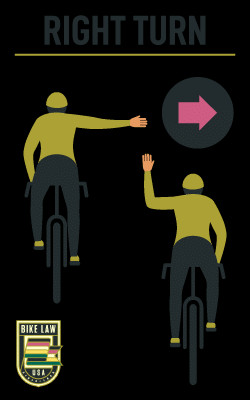Navigating roads safely on a bicycle requires a clear understanding and application of traffic rules, just like driving a car. A crucial aspect of this is effectively communicating your intentions to other road users, especially when turning or changing lanes. Across the globe, cyclists are advised, and in many regions legally mandated, to use Bike Turn Signals, also known as bike hand signals, to indicate their intended movements. While enforcement may vary, the importance of these signals for cyclist safety cannot be overstated. Miscommunication on the road is a significant factor in bicycle accidents, as evidenced by numerous bicycle accident case results. Mastering and consistently using three fundamental bike hand signals is a proactive step every cyclist can take to enhance their safety and prevent potential collisions.
If you’re not yet in the habit of using bike hand signals, now is the ideal time to learn. This guide will detail the essential bike turn signals you need to know for predictable and safe cycling in any environment.
Why Bike Turn Signals Are Essential for Cyclist Safety
In a single year, statistics show the vulnerability of cyclists on the road. For example, in 2015, over 1,000 cyclists tragically lost their lives, and nearly half a million sustained injuries in accidents. While factors like road conditions and infrastructure play a role, a significant portion of these incidents stem from misunderstandings between cyclists and motorists.
Bike turn signals are a vital tool in mitigating the risk of collisions with cars. While no signal can entirely eliminate the danger of negligent drivers, clearly signaling your intended actions significantly reduces the likelihood of being unexpectedly hit. By making your intentions known, you provide drivers with crucial time to react and adjust their driving accordingly.
The benefits of bike turn signals extend beyond interactions with motorists. They are equally important for the safety of fellow cyclists. Whether riding in a group, participating in a peloton, or simply cycling in areas with numerous other bikes, hand signals are essential for group communication and safety. Signaling turns, stops, or slowdowns alerts other cyclists, preventing chain reactions and ensuring smoother, safer group rides. Clear communication through signals promotes a safer and more predictable environment for everyone sharing the road.
Essential Bike Hand Signals Every Cyclist Should Know
Below are the three core bike hand signals that every cyclist should integrate into their riding routine. Before signaling, it’s crucial to perform a quick look back and establish eye contact with drivers and cyclists behind you. This ensures they are aware of your presence and increases the likelihood of them noticing your signals. Situational awareness is key to effective signaling and overall road safety.
Whenever feasible, aim to signal approximately 100 feet before executing your turn or stop. This provides ample reaction time for other road users and allows you to safely return both hands to your handlebars as you maneuver. Hold each signal for about 3 seconds to ensure it is clearly seen and understood before you begin your turn or come to a stop.
Signaling a Left Turn
To indicate a left turn, simply extend your left arm fully out to your side, parallel to the ground. This signal is universally recognized and intuitive for drivers and other cyclists. Ensure you make this signal about 100 feet prior to your turn, allowing sufficient warning time and enabling you to regain full control of your bike with both hands as you initiate the turn.
Signaling a Right Turn
 right turn
right turn
There are a couple of accepted methods for signaling a right turn on a bicycle. The most common and easily understood method is to extend your right arm straight out to your side, mirroring the left turn signal but on the opposite side. This method is straightforward and minimizes confusion.
Alternatively, some regions or cyclists prefer using an upward angled left arm to signal a right turn. To execute this, extend your left arm out to the side and then bend your arm upwards at a 90-degree angle, forming an “L” shape. While this method is less intuitive than the right arm extension, it is still recognized in many areas. Regardless of the method you choose, consistency is key. Ensure you signal about 100 feet before turning and maintain the signal for approximately 3 seconds. It’s advisable to be aware of local preferences or legal requirements regarding right turn signals in your area.
Signaling a Stop or Slowing Down
The stop signal is arguably the most frequently used hand signal by cyclists. Unlike cars, most bicycles lack brake lights, making hand signals the primary way to communicate deceleration or stopping. To signal a stop or intention to slow down, extend your left arm straight out to your side and then bend your arm downwards at a 90-degree angle, with your hand open and facing downwards. This downward pointing hand clearly communicates your intent to reduce speed or come to a complete stop, providing crucial warning to those behind you.
Seeking Guidance After a Bicycle Accident
Experiencing a bicycle accident can be a traumatic event for any cyclist. The aftermath can involve physical injuries, emotional distress, and complex legal and insurance issues. If you’ve been involved in a bike crash, know that you don’t have to navigate the recovery process alone.
If you require expert assistance following an accident, resources are available to connect you with professionals who understand the unique challenges cyclists face. For instance, the Bike Law Network offers connections to independent lawyers and law firms specializing in bicycle accidents, including Florida bicycle accident lawyers. These legal professionals are passionate about cycling and dedicated to advocating for cyclists’ rights. For immediate connection to a Bike Law Lawyer, you can reach out to their network at 1-866-370-8796. Remember, seeking timely and knowledgeable guidance is crucial to protecting your rights and well-being after a bicycle accident.
 Peter Wilborn
Peter Wilborn
Peter Wilborn
Bike Law founder and experienced bicycle crash lawyer, Peter Wilborn, brings both professional expertise and personal passion to the cycling community. Having actively participated in racing, touring, commuting, and recreational riding, Peter understands the cyclist’s perspective intimately. Inspired by a personal bike tragedy in his family in 1998, he dedicated his legal career to Bike Law, recognizing the critical need for legal representation that truly understands the nuances of cycling and bicycle accidents.
